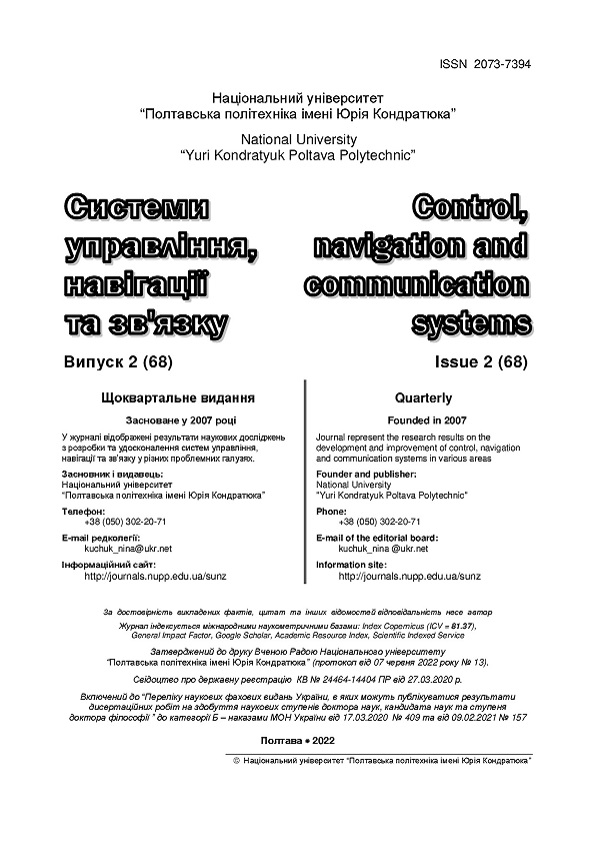РОЗРОБКА СИСТЕМИ ПОДОЛАННЯ ПЕРЕШКОД ДЛЯ БЕЗПІЛОТНОГО ЛІТАЛЬНОГО АПАРАТУ
DOI:
https://doi.org/10.26906/SUNZ.2022.2.032Ключові слова:
безпілотний літальний апарат, система подолання перешкод, лінгвістична змінна, нечітка логікаАнотація
Більшість існуючих безпілотних літальних апаратів (БПЛА) пілотуються за допомогою пультів дистанційного керування. При цьому при виконанні деяких робіт (геологічних, геодезичних, рятувальних, пошукових) є обмеження пов’язані з недостатньою робочою дальністю БПЛА. Тому є необхідність автоматичного керування БПЛА. При автоматичному керуванні БПЛА одним з завдань є формування траєкторії руху БПЛА, при виконанні геодезичних, пошукових та інших робіт, включаючи автоматичне маневрування для обходу перешкод. У разі відсутність інформації про точне розташування перешкод доцільним є управління на основі нечіткої логіки. В статті наведено схему нечіткого логічного висновку. Сукупність значень нечітких вхідних лінгвістичних змінних (ЛЗ), вихідних ЛЗ утворює нечітку базу даних, сукупність правил нечітких продукцій утворює нечітку базу знань. Кожне нечітке число представлене трикутними або трапецієподібними упорядкованими дійсними числами та задано функцією належності. Для опису простору в напряму руху БПЛА використовуються вхідні сигнали датчиків. Після обминання перешкоди навігація БПЛА може здійснюватися за допомогою GPS. Простір в напряму руху БПЛА поділено на п’ять секторів, в яких аналізується наявність перешкод та відстань до них. Введено три вхідні лінгвістичні змінні – дві для аналізу розташування перешкоди (ЛЗ «Горизонталь» та ЛЗ «Вертикаль») та одна для аналізу відстані до перешкоди (ЛЗ «Відстань»). Щодо вихідних змінних, в залежності від розташування перешкоди БПЛА буде змінювати кут рискання, швидкість руху та висоту. Введено три вихідні ЛЗ – «Кут», «Швидкість» та «Висота» та побудовано їх функції належності. Складено базу нечітких продукційних правил виду: якщо «значення вхідних змінних», то «значення вихідний змінних». Використано систему нечіткого виводу типу Мамдані. За допомогою програми перегляду правил системи нечіткого виведення (Rule Viewer) та програми перегляду поверхні системи нечіткого виведення (Surface Viewer) Fuzzy Logic Toolbox проаналізовано результати створеної нечіткої системи. Розроблений у цій статті підхід до запобігання зіткненню БПЛА з перешкодами на основі апарату нечіткої логіки відрізняється від відомих аналогів способом координації БПЛА, сукупністю керуючих правил. Застосування апарату нечіткої логіки дозволяє успішно вирішувати завдання формування траєкторії руху БПЛА в залежності від розташування перешкоди та відстані до неї.Завантаження
Посилання
Заде, Л. Понятие лингвистической переменной и его применение к принятию приближенных решений [Текст]: пер. с англ. / Л. Заде. – М.: Мир, 1976. – 168 с.
Круглов, В.В. Нечеткая логика и искусственные нейронные сети [Текст]: учеб. пособие / В.В. Круглов, М.И. Дли, Р.Ю. Голунов – М.: Издательство физико-математической литературы, 2001. – 224 с.
Штовба, С.Д. Проектирование нечетких систем средствами MATLAB [Текст] / С. Д. Штовба. – М.: Горячая линия - Телеком, 2007. – 288 с.
Интеллектуальное планирование траекторий подвижных объектов в средах с препятствиями [Текст] / под ред. В.Х. Пшихопова. – М.: Физматлит, 2015. – 304 с.




